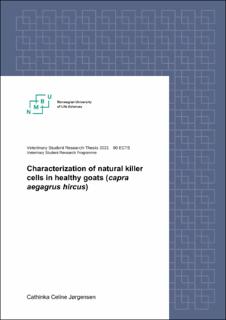| dc.description.abstract | NK cells are essential cells of the innate immune system characterized by their ability to spontaneously eliminate virus-infected cells, tumor cells and all cells that are missing evidence of self. In addition to their immunoprotective properties, they have immunoregulatory functions, such as contributing to a tolerant immune environment during the establishment of pregnancy. NK cells have been thoroughly characterized in humans, mice, pigs, and cattle as well as to some extend in sheep. However, NK cells in goats have not been characterized before. In a world of virus- induced chronic infections, tumor manifestations and complex immune interactions, it is necessary to establish basal knowledge of these important immune cells, to meet the growing demand for immunological model organisms. The main objective of this project was to establish essential methods for describing the phenotype and function of goat NK cells. Several cell selection approaches were performed. One finding was that the anti-ovine NKp46 EC1.1 antibody seemed to result in a higher cell outcome than the anti-bovine NKp46 AKS6 antibody, when performing cell selection with magnetic beads. A functional effector cell assay, including cytotoxicity based on CD107a expression as well as IFN-γ production, was established in goats. Using this method, NKp46+CD3- cells showed typical NK-cell like properties like cytotoxic activity and cytokine production. An observed circulating population of NKp46+CD3+ cells were suspected to be γδT cells. Furthermore, a population of cells that were frequently contaminating NKp46+ cell cultures were CD3+ and were also hypothesized to be γδT cells. To resolve these hypotheses, cell sorting strategies were attempted with the aim to subsequently confirm genes specific for certain cell types by PCR. Time constraints of the research track project did not allow for the fulfillment of the cell sorting tasks and PCR; nevertheless, these data will provide a useful basis for the optimalization of these methods, and the verification of these heterogenous cell populations in goats. | en_US |

